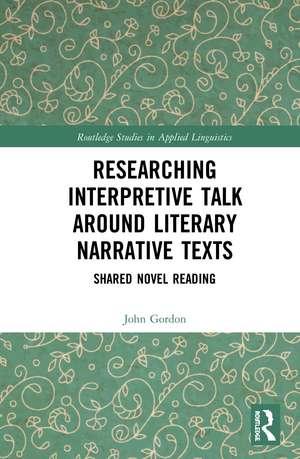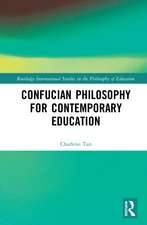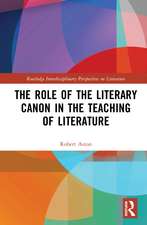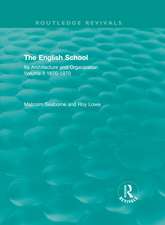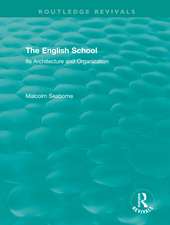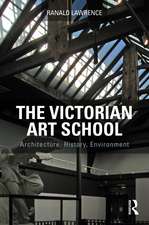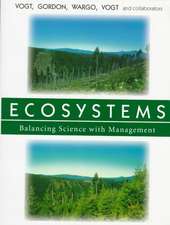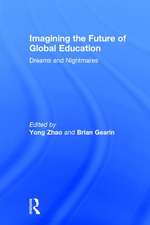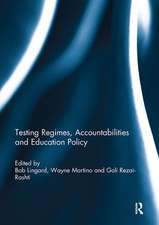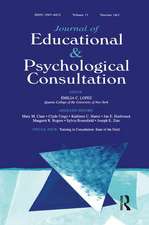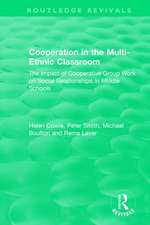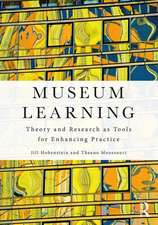Researching Interpretive Talk Around Literary Narrative Texts: Shared Novel Reading: Routledge Studies in Applied Linguistics
Autor John Gordonen Limba Engleză Hardback – 7 oct 2020
| Toate formatele și edițiile | Preț | Express |
|---|---|---|
| Paperback (1) | 258.06 lei 6-8 săpt. | |
| Taylor & Francis – 6 mai 2022 | 258.06 lei 6-8 săpt. | |
| Hardback (1) | 1000.27 lei 6-8 săpt. | |
| Taylor & Francis – 7 oct 2020 | 1000.27 lei 6-8 săpt. |
Din seria Routledge Studies in Applied Linguistics
-
 Preț: 310.29 lei
Preț: 310.29 lei -
 Preț: 326.49 lei
Preț: 326.49 lei - 9%
 Preț: 1006.85 lei
Preț: 1006.85 lei -
 Preț: 309.55 lei
Preț: 309.55 lei -
 Preț: 384.22 lei
Preț: 384.22 lei -
 Preț: 388.30 lei
Preț: 388.30 lei -
 Preț: 389.07 lei
Preț: 389.07 lei - 18%
 Preț: 1000.27 lei
Preț: 1000.27 lei -
 Preț: 365.32 lei
Preț: 365.32 lei - 18%
 Preț: 1002.99 lei
Preț: 1002.99 lei - 18%
 Preț: 1002.63 lei
Preț: 1002.63 lei -
 Preț: 389.66 lei
Preț: 389.66 lei -
 Preț: 389.66 lei
Preț: 389.66 lei -
 Preț: 389.66 lei
Preț: 389.66 lei - 18%
 Preț: 1004.41 lei
Preț: 1004.41 lei -
 Preț: 394.19 lei
Preț: 394.19 lei - 18%
 Preț: 898.95 lei
Preț: 898.95 lei - 9%
 Preț: 934.94 lei
Preț: 934.94 lei -
 Preț: 391.79 lei
Preț: 391.79 lei - 18%
 Preț: 891.85 lei
Preț: 891.85 lei - 18%
 Preț: 1000.51 lei
Preț: 1000.51 lei - 18%
 Preț: 894.53 lei
Preț: 894.53 lei - 18%
 Preț: 1002.50 lei
Preț: 1002.50 lei - 18%
 Preț: 1000.27 lei
Preț: 1000.27 lei -
 Preț: 382.65 lei
Preț: 382.65 lei -
 Preț: 389.96 lei
Preț: 389.96 lei - 18%
 Preț: 1007.72 lei
Preț: 1007.72 lei - 18%
 Preț: 1002.36 lei
Preț: 1002.36 lei - 18%
 Preț: 999.51 lei
Preț: 999.51 lei -
 Preț: 386.61 lei
Preț: 386.61 lei - 18%
 Preț: 1000.27 lei
Preț: 1000.27 lei - 9%
 Preț: 868.79 lei
Preț: 868.79 lei -
 Preț: 384.59 lei
Preț: 384.59 lei - 18%
 Preț: 1002.18 lei
Preț: 1002.18 lei - 18%
 Preț: 1002.99 lei
Preț: 1002.99 lei - 18%
 Preț: 1000.27 lei
Preț: 1000.27 lei
Preț: 1000.27 lei
Preț vechi: 1219.84 lei
-18% Nou
Puncte Express: 1500
Preț estimativ în valută:
191.40€ • 197.46$ • 159.73£
191.40€ • 197.46$ • 159.73£
Carte tipărită la comandă
Livrare economică 26 martie-09 aprilie
Preluare comenzi: 021 569.72.76
Specificații
ISBN-13: 9780367230074
ISBN-10: 0367230070
Pagini: 260
Ilustrații: 2 Line drawings, black and white; 2 Illustrations, black and white
Dimensiuni: 152 x 229 x 16 mm
Greutate: 0.45 kg
Ediția:1Adnotată
Editura: Taylor & Francis
Colecția Routledge
Seria Routledge Studies in Applied Linguistics
Locul publicării:Oxford, United Kingdom
ISBN-10: 0367230070
Pagini: 260
Ilustrații: 2 Line drawings, black and white; 2 Illustrations, black and white
Dimensiuni: 152 x 229 x 16 mm
Greutate: 0.45 kg
Ediția:1Adnotată
Editura: Taylor & Francis
Colecția Routledge
Seria Routledge Studies in Applied Linguistics
Locul publicării:Oxford, United Kingdom
Cuprins
Contents
Chapter 1:
Literary study and shared novel reading in education
1.0 Introduction
1.1 Shared literary reading
1.2 Literary study in education: an overview
1.2.1 Literary pedagogy for supporting students’ comprehension of texts
1.2.2 Conceptualisations of reading
1.2.3 The role of classroom talk in reading
1.3 Shared novel reading
1.4 Readers’ experiences of shared novel reading in education
1.4.1 Questionnaire design and questions
1.4.2 Survey results
1.4 Summary
Chapter 2:
Researching conversations about literature in schools and universities
2.0 Introduction
2.1 Research in the discipline of literary study: some examples
2.1.1 Practical Criticism as research-informed practice
2.1.2 Louise Rosenblatt: ‘Reader Text Poem’
2.1.3 Systematic Functional Linguistics and the verbal arts
2.2 Researching learning conversations
2.3 Researching how voices mediate texts for literary study
2.4 Summary
Chapter 3:
Novels, narratives and narratology
3.0 Introduction
3.1 Key terms
3.1.1 Narrative
3.1.2 Narration
3.1.3 Narratology / narratologies
3.2 The novel as a narrative form: the literary studies perspective
3.3 Novels in education
3.4 Classical narratologies and their use in school English
3.4.1 Propp’s morphology of narrative
3.4.2 Narrative analysis: Labov and Waletzy
3.4.3 Genette and narrative voice
3.4.4 Narrative time: Ricoeur
3.5 New narratologies and their use in researching literary study
3.6 Summary
Chapter 4
Theorising Pedagogic Literary Narration: towards a new narratology of literary study conversations
4.0 Introduction
4.1 Pedagogic Literary Narration
4.1.1 Pedagogic Literary Narration as narration-in-interaction
4.2 Adapting the resources of conversation analysis to literary study contexts
4.3 A three-way view of context for literary study
4.3.1 View 1: institutional contexts for literary study interaction
4.3.2 View 2: Pedagogic Literary Narration as classroom context
4.2.3 View 3: the micro context of Pedagogic Literary Narration in action
4.4 Data sources, settings and participants for this research
4.4.1 Observing shared novel reading in action
4.5 Adapting conversation analysis to Pedagogic Literary Narration
4.6 Reducing and coding conversational literary study data
4.6.1 Stage one: the classroom context of Pedagogic Literary Narration
4.6.2 Stage two: the microcontext of Pedagogic Literary Narration
4.7 An approach to analysing examples of Pedagogic Literary Narration
4.8 Summary
4.8.1 Pedagogic Literary Narration as a classroom context realised in teacher exposition
4.8.2 Towards Pedagogic Literary Narration as micro context: teacher-quoted narration
Chapter 5:
Pedagogic Literary Narration in action
5.0 Introduction
5.1 The focal text: an extract from The Strange Case of Dr Jekyll and Mr Hyde
5.2 An extract from The Strange Case of Dr Jekyll and Mr Hyde discussed in the transcript
5.3 Pedagogic Literary Narration as micro context
5.3.1 Narrating, demonstrating and analysing suspense in teacher exposition
5.3.2 Orchestrating narration, review and analysis through talk
5.4 Theorising narratives and narrative analysis for literary pedagogy
5.4.1 Reviewing Pedagogic Literary Narration in the three-way view of literary study
5.4.2 The nature of narration in Pedagogic Literary Narration
5.4.3 Heteroglot teacher exposition
5.4.4 Recognising some limitations of Pedagogic Literary Narration and these research methods
5.5 Summary
Chapter 6:
Spoken quotation in Pedagogic Literary Narration: Introducing QuoTE Analysis
6.0 Introduction
6.0.1 Focal texts: Jekyll and Hyde, and The Boy in the Striped Pyjamas
6.0.2 Examples of spoken quotation in shared novel reading
6.1 Reader positioning around quotations in literary study
6.1.1 Quotation in literary study
6.1.2 Positioning theory for literary pedagogy
6.2 Quotations: From page to talk
6.3 The turn of the page: Study text as participant in literary-critical talk
6.4 The third turn or mini-lecture in classroom interaction
6.5 QuoTE analysis
6.6 Spoken quotation in shared literary reading
6.6.1 Spoken quotation in teacher exposition, senior classroom
6.6.2 Spoken quotation in on-going read-aloud talk, junior classroom
6.7 Spoken quotations in literary-critical talk
6.8 Summary
Chapter 7:
Elaborating characters through conversation
7.0 Introduction
7.1 Elaborating character development together in primary school
7.1.1 Establishing character development as a focus
7.1.2 Accounting for character development together
7.1.3 Indexing a psychological character trait
7.1.4 Elaborating character development together in Pedagogic Literary Narration
7.2 Conceptualising character together in secondary school
7.3 Analysing character through intertexts in higher education
7.3.1 The focal text: Tom Jones by Henry Fielding
7.3.2 Discussing characterisation in Tom Jones
7.4 Summary
Chapter 8:
Discussing literary narratives in higher education: intertextuality and tethering
8.0 Introduction
8.1 A university seminar in a Contemporary Fiction module of literary study
8.2 The focal text: Pond, by Claire-Louise Bennett
8.3 Critical intertexts influencing seminar discussion
8.3.1 An online review of Pond
8.3.2 A published interview with Pond’s author, Claire-Louise Bennet
8.4 Intertextuality, positioning theory and interaction
8.4.1 What is intertextuality?
8.4.2 Positioning theory and intertextuality
8.5 Intertexuality in seminar discussion
8.5.1 Invoking texts and invocations
8.5.2 Call codes: identifying the many voices of intertexts
8.5.3 Lemke’s categories of intertextual relationship
8.6 Discussing ‘Pond’ together: Conversation analysis
8.6.1 Discussing ‘Pond’ together: transcript
8.6.2 How do participants enact intertextual literary analysis in conversation?
8.6.3 How are intertextual voices introduced?
8.6.4 How do intertextual voices relate to focal texts and position readers’ orientations to them?
8.7 Tethering intertextual talk
8.8 Summary
Chapter 9:
Building themes together: Talk about literary novels in and beyond formal education
9.0 Introduction
9.0.1 Shared reading in an informal book group
9.0.2 Focal text: Life after Life by Kate Atkinson
9.03 Finding an analytic approach suited to informal shared literary reading
9.1 Framing shared literary reading of Life after Life
9.1.0 Participants frame conversation about Life after Life: an informal agenda
9.1.1 Framing book group conversation for analysis
9.2 Life after Life: extended plain text transcripts
9.2.1 Plain transcript 1: representing parallel life stories, and catalyst events
9.2.2 Plain transcript 2: chance and the ‘what if’ conceit
9.2.3 Plain transcript 3: form and Life after Life as a ‘what if’ book
9.2.4 Plain transcript 4: Constant Izzie and déjà vu – ‘time is not linear’
9.3 Discussing Life after Life: Conversation analysis
9.3.0 Repetition as a resource in conversation
9.4.0 Annotated transcript 1: maintaining diffuse text topics through repetition - ‘in Germany’
9.3.2 Annotated transcript 2: collective text analysis through categorisation statements – ‘the what if scenario’
9.3.3 Annotated transcript 3: considering the novel’s form by proxy - ‘difficult to film’
9.3.4 Annotated transcript 4: deictic analysis - ‘time is not linear’
9.4 Summary
Chapter 10
Discussing and navigating narrative form: How texts shape talk
10.0 Introduction
10.1 The epistolary form of Daddy Long-legs and genre theory
10.1.1 The epistolary novel
10.1.2 Genre theory
10.2 Positioning theory and short stories
10.3 Short storying to position reading and readers of Daddy Long-legs
10.3.1 Short storying to express and invite reading positions to Daddy Long-legs
10.3.2 Reporting the focal text narrative: short story summaries
10.4 Orienting to analytic reading positions around Daddy Long-legs
10.4.1 Reader positioning arising from focal text form
10.4.2 Reader positioning oriented to focal text as a generic object
10.5 Summary
Chapter 11
Developing Pedagogic Literary Narration for teaching literature
11.0 Introduction
11.1 Literary classroom discourse as pedagogic device
11.1.1 The pedagogic device
11.1.2 Public language
11.1.3 Language codes
11.1.4 The value of ‘restricted’ shared reading conversations
11.2 Connecting reading group conversations with formal education
11.2.1 Extra-narration in reading groups relative to formal literary education
11.2.2 Paraphrased narrative in reading group conversations
11.2.3 Intertextual text invocation in reading group conversations
11.2.4 ‘Talkable texts’: repetition and synecdochic indexing in reading group talk
11.3 Reviewing shared literary reading in formal education
11.3.1 Involvement, narration and positioning
11.3.2 Turn-taking patterns and the collective achievement of literary analysis
11.3.3 Initiate-response-evaluate, teacher exposition and the pedagogic device of
literary study
11.3.4 Spoken quotation: an essential feature of spoken literary discourse?
11.3.5 How and how much texts enter talk
11.4 Summary
Chapter 12:
Interpretive talk around literary narrative texts: an overview
12.0 An overview
12.1 The analytic resources generated by this study
12.2 A narratology for interpretive talk around literary narrative texts
12.2.1 The significance of this narratology for education research
12.2.2 The significance of shared novel reading and Pedagogic Literary Narration for education
12.3 New stories for teachers of literature
12.3.1 Eavesdropping on shared novel reading in teacher education
12.3.2 Teacher-researchers: shared literary reading in a Masters-level programme
12.4 Summary
Tables
Table 4.1 Shared novel reading: observed examples
Table 4.2 Focal class data, The Strange Case of Dr Jekyll and Mr Hyde
Table 4.3 Teacher exposition, teacher-quoted narrative comprising multi-quotation turns
Table 6.1 Positioning affordances of spoken quotation in literary pedagogy
Table 8.1 Call codes – voices of human agents
Table 8.2 Call codes - verbal text voices
Table 10.1 Three levels of positioning questions, after Rattansi & Phoenix
Table 12.1 Key terms for researching interpretive talk around literary narrative texts during shared novel reading
Figures
Figure 12.1 A post-classical narratology for interpretive talk around literary narrative texts
Figure 12.2 Shared novel reading: observing other teachers / evaluating your own teaching
References
Appendix
Chapter 1:
Literary study and shared novel reading in education
1.0 Introduction
1.1 Shared literary reading
1.2 Literary study in education: an overview
1.2.1 Literary pedagogy for supporting students’ comprehension of texts
1.2.2 Conceptualisations of reading
1.2.3 The role of classroom talk in reading
1.3 Shared novel reading
1.4 Readers’ experiences of shared novel reading in education
1.4.1 Questionnaire design and questions
1.4.2 Survey results
1.4 Summary
Chapter 2:
Researching conversations about literature in schools and universities
2.0 Introduction
2.1 Research in the discipline of literary study: some examples
2.1.1 Practical Criticism as research-informed practice
2.1.2 Louise Rosenblatt: ‘Reader Text Poem’
2.1.3 Systematic Functional Linguistics and the verbal arts
2.2 Researching learning conversations
2.3 Researching how voices mediate texts for literary study
2.4 Summary
Chapter 3:
Novels, narratives and narratology
3.0 Introduction
3.1 Key terms
3.1.1 Narrative
3.1.2 Narration
3.1.3 Narratology / narratologies
3.2 The novel as a narrative form: the literary studies perspective
3.3 Novels in education
3.4 Classical narratologies and their use in school English
3.4.1 Propp’s morphology of narrative
3.4.2 Narrative analysis: Labov and Waletzy
3.4.3 Genette and narrative voice
3.4.4 Narrative time: Ricoeur
3.5 New narratologies and their use in researching literary study
3.6 Summary
Chapter 4
Theorising Pedagogic Literary Narration: towards a new narratology of literary study conversations
4.0 Introduction
4.1 Pedagogic Literary Narration
4.1.1 Pedagogic Literary Narration as narration-in-interaction
4.2 Adapting the resources of conversation analysis to literary study contexts
4.3 A three-way view of context for literary study
4.3.1 View 1: institutional contexts for literary study interaction
4.3.2 View 2: Pedagogic Literary Narration as classroom context
4.2.3 View 3: the micro context of Pedagogic Literary Narration in action
4.4 Data sources, settings and participants for this research
4.4.1 Observing shared novel reading in action
4.5 Adapting conversation analysis to Pedagogic Literary Narration
4.6 Reducing and coding conversational literary study data
4.6.1 Stage one: the classroom context of Pedagogic Literary Narration
4.6.2 Stage two: the microcontext of Pedagogic Literary Narration
4.7 An approach to analysing examples of Pedagogic Literary Narration
4.8 Summary
4.8.1 Pedagogic Literary Narration as a classroom context realised in teacher exposition
4.8.2 Towards Pedagogic Literary Narration as micro context: teacher-quoted narration
Chapter 5:
Pedagogic Literary Narration in action
5.0 Introduction
5.1 The focal text: an extract from The Strange Case of Dr Jekyll and Mr Hyde
5.2 An extract from The Strange Case of Dr Jekyll and Mr Hyde discussed in the transcript
5.3 Pedagogic Literary Narration as micro context
5.3.1 Narrating, demonstrating and analysing suspense in teacher exposition
5.3.2 Orchestrating narration, review and analysis through talk
5.4 Theorising narratives and narrative analysis for literary pedagogy
5.4.1 Reviewing Pedagogic Literary Narration in the three-way view of literary study
5.4.2 The nature of narration in Pedagogic Literary Narration
5.4.3 Heteroglot teacher exposition
5.4.4 Recognising some limitations of Pedagogic Literary Narration and these research methods
5.5 Summary
Chapter 6:
Spoken quotation in Pedagogic Literary Narration: Introducing QuoTE Analysis
6.0 Introduction
6.0.1 Focal texts: Jekyll and Hyde, and The Boy in the Striped Pyjamas
6.0.2 Examples of spoken quotation in shared novel reading
6.1 Reader positioning around quotations in literary study
6.1.1 Quotation in literary study
6.1.2 Positioning theory for literary pedagogy
6.2 Quotations: From page to talk
6.3 The turn of the page: Study text as participant in literary-critical talk
6.4 The third turn or mini-lecture in classroom interaction
6.5 QuoTE analysis
6.6 Spoken quotation in shared literary reading
6.6.1 Spoken quotation in teacher exposition, senior classroom
6.6.2 Spoken quotation in on-going read-aloud talk, junior classroom
6.7 Spoken quotations in literary-critical talk
6.8 Summary
Chapter 7:
Elaborating characters through conversation
7.0 Introduction
7.1 Elaborating character development together in primary school
7.1.1 Establishing character development as a focus
7.1.2 Accounting for character development together
7.1.3 Indexing a psychological character trait
7.1.4 Elaborating character development together in Pedagogic Literary Narration
7.2 Conceptualising character together in secondary school
7.3 Analysing character through intertexts in higher education
7.3.1 The focal text: Tom Jones by Henry Fielding
7.3.2 Discussing characterisation in Tom Jones
7.4 Summary
Chapter 8:
Discussing literary narratives in higher education: intertextuality and tethering
8.0 Introduction
8.1 A university seminar in a Contemporary Fiction module of literary study
8.2 The focal text: Pond, by Claire-Louise Bennett
8.3 Critical intertexts influencing seminar discussion
8.3.1 An online review of Pond
8.3.2 A published interview with Pond’s author, Claire-Louise Bennet
8.4 Intertextuality, positioning theory and interaction
8.4.1 What is intertextuality?
8.4.2 Positioning theory and intertextuality
8.5 Intertexuality in seminar discussion
8.5.1 Invoking texts and invocations
8.5.2 Call codes: identifying the many voices of intertexts
8.5.3 Lemke’s categories of intertextual relationship
8.6 Discussing ‘Pond’ together: Conversation analysis
8.6.1 Discussing ‘Pond’ together: transcript
8.6.2 How do participants enact intertextual literary analysis in conversation?
8.6.3 How are intertextual voices introduced?
8.6.4 How do intertextual voices relate to focal texts and position readers’ orientations to them?
8.7 Tethering intertextual talk
8.8 Summary
Chapter 9:
Building themes together: Talk about literary novels in and beyond formal education
9.0 Introduction
9.0.1 Shared reading in an informal book group
9.0.2 Focal text: Life after Life by Kate Atkinson
9.03 Finding an analytic approach suited to informal shared literary reading
9.1 Framing shared literary reading of Life after Life
9.1.0 Participants frame conversation about Life after Life: an informal agenda
9.1.1 Framing book group conversation for analysis
9.2 Life after Life: extended plain text transcripts
9.2.1 Plain transcript 1: representing parallel life stories, and catalyst events
9.2.2 Plain transcript 2: chance and the ‘what if’ conceit
9.2.3 Plain transcript 3: form and Life after Life as a ‘what if’ book
9.2.4 Plain transcript 4: Constant Izzie and déjà vu – ‘time is not linear’
9.3 Discussing Life after Life: Conversation analysis
9.3.0 Repetition as a resource in conversation
9.4.0 Annotated transcript 1: maintaining diffuse text topics through repetition - ‘in Germany’
9.3.2 Annotated transcript 2: collective text analysis through categorisation statements – ‘the what if scenario’
9.3.3 Annotated transcript 3: considering the novel’s form by proxy - ‘difficult to film’
9.3.4 Annotated transcript 4: deictic analysis - ‘time is not linear’
9.4 Summary
Chapter 10
Discussing and navigating narrative form: How texts shape talk
10.0 Introduction
10.1 The epistolary form of Daddy Long-legs and genre theory
10.1.1 The epistolary novel
10.1.2 Genre theory
10.2 Positioning theory and short stories
10.3 Short storying to position reading and readers of Daddy Long-legs
10.3.1 Short storying to express and invite reading positions to Daddy Long-legs
10.3.2 Reporting the focal text narrative: short story summaries
10.4 Orienting to analytic reading positions around Daddy Long-legs
10.4.1 Reader positioning arising from focal text form
10.4.2 Reader positioning oriented to focal text as a generic object
10.5 Summary
Chapter 11
Developing Pedagogic Literary Narration for teaching literature
11.0 Introduction
11.1 Literary classroom discourse as pedagogic device
11.1.1 The pedagogic device
11.1.2 Public language
11.1.3 Language codes
11.1.4 The value of ‘restricted’ shared reading conversations
11.2 Connecting reading group conversations with formal education
11.2.1 Extra-narration in reading groups relative to formal literary education
11.2.2 Paraphrased narrative in reading group conversations
11.2.3 Intertextual text invocation in reading group conversations
11.2.4 ‘Talkable texts’: repetition and synecdochic indexing in reading group talk
11.3 Reviewing shared literary reading in formal education
11.3.1 Involvement, narration and positioning
11.3.2 Turn-taking patterns and the collective achievement of literary analysis
11.3.3 Initiate-response-evaluate, teacher exposition and the pedagogic device of
literary study
11.3.4 Spoken quotation: an essential feature of spoken literary discourse?
11.3.5 How and how much texts enter talk
11.4 Summary
Chapter 12:
Interpretive talk around literary narrative texts: an overview
12.0 An overview
12.1 The analytic resources generated by this study
12.2 A narratology for interpretive talk around literary narrative texts
12.2.1 The significance of this narratology for education research
12.2.2 The significance of shared novel reading and Pedagogic Literary Narration for education
12.3 New stories for teachers of literature
12.3.1 Eavesdropping on shared novel reading in teacher education
12.3.2 Teacher-researchers: shared literary reading in a Masters-level programme
12.4 Summary
Tables
Table 4.1 Shared novel reading: observed examples
Table 4.2 Focal class data, The Strange Case of Dr Jekyll and Mr Hyde
Table 4.3 Teacher exposition, teacher-quoted narrative comprising multi-quotation turns
Table 6.1 Positioning affordances of spoken quotation in literary pedagogy
Table 8.1 Call codes – voices of human agents
Table 8.2 Call codes - verbal text voices
Table 10.1 Three levels of positioning questions, after Rattansi & Phoenix
Table 12.1 Key terms for researching interpretive talk around literary narrative texts during shared novel reading
Figures
Figure 12.1 A post-classical narratology for interpretive talk around literary narrative texts
Figure 12.2 Shared novel reading: observing other teachers / evaluating your own teaching
References
Appendix
Notă biografică
John Gordon is Senior Lecturer in Education at the School of Education and Lifelong Learning at the University of East Anglia, UK.
Descriere
Drawing on a multidisciplinary approach integrating insights from conversation analysis, narrative analysis, and narratology, this book theorizes teaching around narrative prose in each level of education, with a focus on a new framework of Pedagogic Literary Narration.
